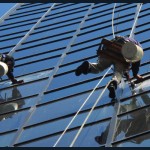 Most very tall buildings still require brave souls to dangle in a precarious cart as they go to work washing the windows. It’s common for this to be an ongoing process, with the windows at the top requiring a fresh clean by the time the cleaners have made it to the base.
Most very tall buildings still require brave souls to dangle in a precarious cart as they go to work washing the windows. It’s common for this to be an ongoing process, with the windows at the top requiring a fresh clean by the time the cleaners have made it to the base.
A team of researchers from University College London (UCL) are working on a new type of smart window that is capable of cleaning itself, thus considerably cutting cleaning costs for the building managers, whilst also removing a precarious and unsafe profession.
Smart windows
The windows are developed using nanostructures that have been designed to mimic the way moth eyes clean themselves. It’s been developed with three things in mind:
- Being self-cleaning – the material is ultra-resistant to water so rain rolls over the surface, taking dirt and dust with it on the way. It achieves this via some super smart nanostructures engraved onto the glass that trap air and ensure that a tiny amount of water comes into contact with the surface.
- Energy saving – the glass also has a 5-10 nanometer film of vanadium dioxide that stops thermal radiation escaping, thus retaining heat inside the building. When it’s warm outside, it is also capable of stopping infrared radiation entering the building. Vanadium dioxide is a cheap and abundant material so offers some real cost-effectiveness.
- Anti-glare – the nanostructures have been designed such that they mimic the anti-reflective properties found in moth eyes, and other creatures that have evolved to hide from predators. The approach ensures that less than 5% of light is reflected internally in a room and is a marked reduction on traditional methods
“This is the first time that a nanostructure has been combined with a thermochromic coating. The bio-inspired nanostructure amplifies the thermochromics properties of the coating and the net result is a self-cleaning, highly performing smart window,” the team say.
Energy saving
It’s believed that the windows could reduce heating bills by up to 40%, depending on where exactly on the building they’re incorporated. It isn’t clear however, how much more expensive the windows are than those traditionally used in high-rise developments. Nonetheless, the team are optimistic.
“It’s currently estimated that, because of the obvious difficulties involved, the cost of cleaning a skyscraper’s windows in its first 5 years is the same as the original cost of installing them. Our glass could drastically cut this expenditure, quite apart from the appeal of lower energy bills and improved occupant productivity thanks to less glare. As the trend in architecture continues towards the inclusion of more glass, it’s vital that windows are as low-maintenance as possible,” they say.
The next step is to partner with manufacturers to produce the windows at a cost-effective price. The key challenge will be to scale up the nano-manufacturing methods used in the windows, as well as the method by which they are coated in vanadium dioxide.
It’s hoped that the windows could eventually reach the market in the next 3-5 years, depending largely on the team’s success in getting an industrial partner.
It’s an interesting project that is certainly one to keep an eye on.
If you liked this post, buy me a coffee
Very clever, but I suppose as you say, the key consideration will be a financial one. Is the initial outlay offset by reduced cleaning costs? Crack that and this could be a hugely successful technology.
Sounds just what I need – where can I buy one?
Durable and maintenance-free ! Really smart ! Love the fact that it is Energy Saving… but I guess that means we wont be offering (Window Cleaning) any more